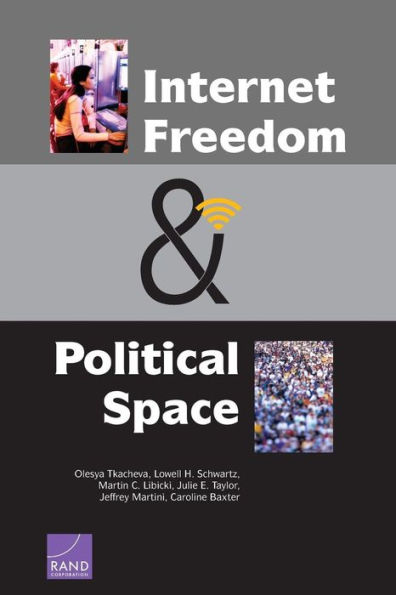Table of Contents
Preface iii
Figures and Tables ix
Summary xi
Acknowledgments xxi
Abbreviations xxiii
Chapter 1 Introduction: The Autocratic Challenge and Internet Freedom 1
Political Space and the Internet 4
Styles of Repression 7
Introduction to Internet Freedom Programs 12
Organization of the Report 14
Chapter 2 The Internet and Political Process in Different Regimes 17
Is the Internet Transforming Politics? Where and How? 19
Cyberactivism in Democratic and Nondemocratic Regimes 24
How and Where Can Internet Freedom (Technologies) Transform Political Space? 28
Political Communication and Social Mobilization 29
Internet Freedom and Framing Process 32
Key Actors in Cyberspace 32
Bloggers, Netizens, and Political Space 35
Web 2.0 Users and Political Space 35
Online Activists and Political Space 37
Internet Freedom and the Modes of Transformation of Political Space 38
Conclusion 41
Chapter 3 Cyber activists, Social Media, and the Anti-Mubarak Protests in Egypt 43
Social Media's Significance: The Debate 47
Cyberenthusiasts 48
Cyber-Killjoys 49
How Social Media Bridged Egypt's Mobilization Gaps 55
Social Media Was the Opposition's Only Tool for Reaching and Mobilizing a Mass Base 55
No Other Opposition Force Would Confront the State with Mass Action 65
Military Considered Defection Only After Demonstrations Grew and It Was Forced to Either Shoot or Remove Mubarak 68
Conclusion: What This Means for the Study of Social Media 70
Chapter 4 Internet Freedom and Political Change in Syria 73
Internet Usage by the Numbers 74
Internet Censorship 77
Use of the Internet in the Syrian Uprising 79
Circumvention Technologies During the' Protests 82
Regime Adaptation 83
External Dimensions 87
How Internet Freedom Affected Political Change in Syria 89
Chapter 5 The Internet in China: Threatened Tool of Expression and Mobilization 93
Netizens and Authorities in Cyberspace 95
Censorship and Circumvention Methods 96
Online Activists and Authorities in Political Space 101
Online Mobilization and Policy Outcomes 103
Wenzhou Train Crash 104
Dalian Chemical Plant 107
Internet and Popular Mobilization in Rural Areas 110
Ethnic Riots and the Internet 112
Internet Freedom Technologies: Tools for the Motivated Elites or Mass-Use Technologies? 116
Chapter 6 Fighting Electoral Fraud in the 2011 Russian Election with Internet and Social Media 119
Critical Information and Postelection Protests 120
RuNet: Russian Internet 124
Russian Authorities and Cyberactivists 127
Golos and Online Election Fraud. Reporting 130
Golos and Citizens' Whistle-Blowing 133
Electoral Fraud, Social Media, and Post-Election Protests 139
Social Media and Voter Mobilization 141
Conclusion 145
Chapter 7 Information Freedom During the Cold War: The Impact of Western Radio Broadcasts 149
Short-Term and Long-Term Objectives of RFE/RL 150
Measuring the Size of RFE/RL Audiences and Determining Its Effectiveness 157
The Role of RFE/RL in Social Unrest 162
Learning from the Cold War Experience: Lessons and Analysis from Communist Archives for Promoting Internet Freedom 171
What Impact Did U.S. Policymakers Hope to Achieve Through Their Efforts to Improve Communist Citizens' Access to Outside Information? 171
How Could RFE/RL Safely Assist Opposition Figures and Parties to the Communist Regime? How Did this Assistance Affect the Political Space? 173
What Did Communist Authorities Hope to Achieve Through Jamming Western Radio Broadcasts? How Did Western Broadcasters Attempt to Overcome Jamming? Did Jamming Alter the Impact of Western Radio Broadcasts? 176
Who Was the Target Audience for Western Short-Wave Broadcasts? How Confrontational Toward Communist Authorities Should the Broadcasts Be? 179
How Did U.S. Policymakers Measure Success in the Medium and Long Term of Western Radio Broadcasts? 182
Chapter 8 Internet Freedom: Measure and Countermeasure 185
The Struggle for Internet Freedom: A Multiplayer Strategic Competition 190
Countermeasures and Counter-Countermeasures 192
No or Expensive Internet 192
Halal Internet 193
Site and Content Blocking 194
Green Dam 196
Pwning Dissident Computers 196
Finding and Targeting Dissidents Through Their Internet Use 197
DDOS Attacks 198
50-Cent Party 199
Exceptional Violence 199
Greater Surveillance of Mobile Communication 200
The Future Architecture of the Internet 201
Chapter 9 Key Findings and Policy Implications for Internet Freedom Programs' Design 203
Summary of Case Studies: The Relationship Between Internet Freedom and Political Space 204
Impact of Opportunity Structures on the Outcomes of Online Mobilization 211
Implications for the Design and Implementation of Internet Freedom Programs 213
Leveraging Internet Freedom Programs: Maximizing Their Impact and Understanding Their Limitations 216
Appendix: Electoral Fraud Variable and Summary Statistics for the Russia Case Study 223
Bibliography 231



